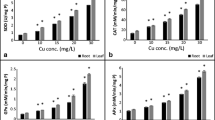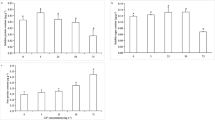Abstract
This study concerned the accumulation of trace metals in tissues of seagrass (Thalassia hemprichii) exposed to various concentrations of Zn2+, Cd2+, Pb2+ and Cu2+ for 10 d, and the effect of excessive metals on quantum yield (ΔF/F′m ), photosynthetic pigments and antioxidative enzymes like superoxide dismutase (SOD), guaiacol peroxidase (POD) were also examined. Cadmium was the most highly accumulated metal. Meanwhile, high metals levels led to a remarkable breakdown of photosynthetic parameters. Especially, ΔF/F′m, chlorophyll and carotenoid were significantly low during prolonged Cu exposure. Besides, ΔF/F′m was more severely depressed by Cu and Zn than Pb and Cd. However, T. hemprichii had positive response by increasing the activity of SOD and POD. The results indicate that T. hemprichii is the most sensitive to Cu, and the antioxidative protection mechanisms of T. hemprichii are more efficiently activated to avoid damage of Zn, Cd and Pb stress. Finally, due to the high Cd-accumulation and strong Cd-tolerance capacity, T. hemprichii can be used for phytoremediation in Cd-contaminated areas.
Similar content being viewed by others
References
Ahmed A, Tajmir-Riahi H A. 1993. Interaction of toxic metal ions Cd2+, Hg2+, and Pb2+ with lightharvesting proteins of chloroplast thylakoid membranes. An FTIR spectroscopic study. Journal of Inorganic Biochemistry, 50(4): 235–243
Apel K, Hirt H. 2004. Reactive oxygen species: metabolism oxidative stress, and signaling transduction. Annual Review of Plant Biology, 55: 373–399
Arnon D I. 1949. Copper enzymes in isolated chloroplasts. Polyphenol oxidase in Beta vulgaris. Plant physiology, 24(1): 1–15
Beauchamp C O, Fridovich I. 1971. Superoxide dismutase: improved assays and an assay applicable to acrylamide gels. Analytical biochemistry, 44(1): 276–287
Cao Te, Ni Leyi, Xie Ping. 2004. Acute biochemical responses of a submersed macrophyte, Potamogeton crispus L., to high ammonium in an aquarium experiment. Journal of Freshwater Ecology, 19(2): 279–284
Caspi V, Droppa M, Horváth G, et al. 2000. The effect of copper on chlorophyll organization during greening of barley leaves. Photosynthesis Research, 62(2): 165–174
Catalado D A, Garland T R, Wildung R E. 1983. Cadmium uptake kinetics in intact soybean plants. Plant physiology, 73(3): 844–848
den Hartog C, Yang Zongdai. 1990. A catalogue of the seagrasses of China. Chinese Journal of Oceanology and Limnology, 8(1): 74–91
Di Toppi L S, Castagna A, Andreozzi E, et al. 2009. Occurrence of different inter-varietal and inter-organ defence strategies towards supra-optimal zinc concentrations in two cultivars of Triticum aestivum L. Environmental and Experimental Botany, 66(2): 220–229
Drążkiewicz M, Baszyński T. 2005. Growth parameters and photosynthetic pigments in leaf segments of Zea mays exposed to cadmium, as related to protection mechanisms. Journal of Plant Physiology, 162(9, 14): 1013–1021
Ebbs S D, Kochian L V. 1997. Toxicity of Zinc and Copper to Brassica species: implications for phytoremediation. Journal of Environmental Quality, 26(3): 776–781
Fatima R A, Ahmad M. 2005. Certain antioxidant enzymes of Allium cepa as biomarkers for the detection of toxic heavy metals in wastewater. Science of Total Environment, 346(1–3): 256–273
Ferrat L, Bingert A, Roméo M, et al. 2002a. Mercury uptake and enzymatic response of Posidonia oceanica after an experimental exposure to organic and inorganic forms. Environmental Toxicology and Chemistry, 21(11): 2365–2371
Ferrat L, Roméo M, Gnassia-Barelli M, et al. 2002b. Effects of mercury on antioxidant mechanisms in the marine phanerogam Posidonia oceanica. Diseases of Aquatic Organisms, 50(2): 157–160
Hamoutene D, Roméo M, Gnassia M, et al. 1996. Cadmium on oxidative metabolism in a marine seagrass: Posidonia oceanica. Bulletin of Environmental Contamination and Toxicology, 56(2): 327–334
Hoagland D R, Arnon D I. 1950. The water-culture method for growing plants without soil. California Agricultural Experimental Station Circular, 347(2): 1–32
Huang Xiaoping, Huang Liangmin, Li Yinghong, et al. 2006. Main seagrass beds and threats to their habitats in the coastal sea of South China. Chinese Science Bulletin, 51(Supp II): 136–142
Huang Guoyong, Wang Youshao. 2010. Physiological and biochemical responses in the leaves of two mangrove plant seedlings (Kandelia candel and Bruguiera gymnorrhiza) exposed to multiple heavy metals. Journal of Hazardous Materials, 182(1–3): 848–854
Lafabrie C, Pergent-Martini C, Pergent G. 2008. First results on the study of metal contamination along the Corsican coastline using Posidonia oceanica. Marine Pollution Bulletin, 57(1–5): 155–159
Liu Nan, Lin Zhifang, Lin Guizhu, et al. 2010. Lead and cadmium induced alterations of cellular functions in leaves of Alocasia macrorrhiza L. Schott. Ecotoxicology and Environmental Safety, 73(6): 1238–1245
MacFarlane G R, Burchett M D. 2001. Photosynthetic Pigments and Peroxidase Activity as Indicators of Heavy Metal Stress in the Grey Mangrove, Avicennia marina (Forsk.) Vierh. Marine Pollution Bulletin, 42(3): 233–240
Macinnis-Ng C M O, Ralph P J. 2002. Towards a more ecologically relevant assessment of the impact of heavy metals on the photosynthesis of the seagrass, Zostera capricorni. Marine Pollution Bulletin, 45(1–12): 100–106
Malea P, Haritonidis S. 1995. Local distribution and seasonal variation of Fe, Ph, Zn, Cu, Cd, Na, K, Ca, and Mg concentrations in the seagrass Cymodocea nodosa (Ucria) Aschers in the Antikyra Gulf, Greece. Marine Ecology, 16(1): 41–56
Marschner H. 1995. Mineral Nutrition of Higher Plants. 2nd ed. San Diego: Academic Press
Mishra S, Srivastava S, Tripathi R D, et al. 2006a. Lead detoxification by coontail (Ceratophyllum demersum L.) involves induction of phytochelatins and antioxidant system in response to its accumulation. Chemosphere, 65(6): 1027–1039
Mishra S, Srivastava S, Tripathi R D, et al. 2006b. Phytochelatin synthesis and response of antioxidants during cadmium stress in Bacopa monnieri L. Plant physiology and biochemistry, 44(1): 25–37
Mukai H. 1993. Biogeography of the tropical seagrasses in the Western Pacific. Australian Journal of Marine and Freshwater Research, 44(1): 1–17
Ouzounidou G. 1994. Copper-induced changes on growth, metal content and photosynthetic function of Alyssum montanum L. plants. Environmental and Experimental Botany, 34(2): 165–172
Pergent-Martini C, Pergent G. 2000. Marine phanerogams as a tool in the evaluation of marine trace-metal contamination: an example from the Mediterranean. International Journal of Environment and Pollution, 13(1–6): 126–147
Prange J A, Dennison W C. 2000. Physiological responses of five seagrass species to trace metals. Marine Pollution Bulletin, 41(7–12): 327–336
Prasad M N V, Strzalka K. 1999. Impact of heavy metals on photosynthesis. In: Prasad M N V, Hagemeyer J, eds. Heavy Metal Stress in Plants. Berlin: Springer, 117–138
Ralph P J, Burchett M D. 1998. Photosynthetic response of Halophila ovalis to heavy metal stress. Environmental Pollution, 103(1): 91–101
Reddy A M, Kumar S G, Jyonthsnakumari G, et al. 2005. Lead induced changes in antioxidant metabolism of horsegram (Macrotyloma uniflorum (Lam.) Verdc.) and bengalgram (Cicer arietinum L.). Chemosphere, 60(1): 97–104
Salin M L. 1988. Toxic oxygen species and protective systems of the chloroplast. Physiologia Plantarum, 72(3): 681–689
Schreiber U, Bilger W, Neubauer C. 1994. Chlorophyll fluorescence as a non-intrusive indicator for rapid assessment of in vivo photosynthesis. In: Schulze M, Caldwell M M, eds. Ecophysiology of Photosynthesis. Berlin: Springer, 49–70
Schützendübel A, Polle A. 2002. Plant responses to abiotic stresses: heavy metal-induced oxidative stress and protection by mycorrhization. Journal of Experimental Botany, 53(372): 1351–1365
Sinha S, Sinam G, Mishra R K, et al. 2010. Metal accumulation, growth, antioxidants and oil yield of Brassica juncea L. exposed to different metals. Ecotoxicology and Environmental Safety, 73(6): 1352–1361
Srivastava S, Mishra S, Tripathi R D, et al. 2006. Copperinduced oxidative stress and responses of antioxidants and phytochelatins in Hydrilla verticillata (L.f.) Royle. Aquatic Toxicology, 80(4): 405–415
Stobrawa K, Lorenc-Plucińska G. 2008. Thresholds of heavy-metal toxicity in cuttings of European black poplar (Populus nigra L.) determined according to antioxidant status of fine roots and morphometrical disorders. Science of Total Environment, 390(1): 86–96
Tiller K G, Merry R H, Zarcinas B A, et al. 1989. Regional geochemistry of metal-contaminated surficial sediments and seagrasses in upper Spencer Gulf, South Australia. Estuarine, Coastal and Shelf Science, 28(5): 473–493
Upadhyaya A, Sankhla D, Davis T D, et al. 1985. Effect of paclobutrazol on the activities of some enzymes of activated oxygen metabolism and lipid peroxidation in senescing soybean leaves. Journal of Plant Physiology, 121(5): 453–461
Vangronsveld J, Clijsters H. 1994. Toxic effects of metals. In: Farago M E, ed. Plants and The Chemical Elements-Biochemistry, Uptake, Tolerance and Toxicity. Weinheim: VCH, 149–177
Wang Chao, Zhang Songhe, Wang Peifang, et al. 2009. The effect of excess Zn on mineral nutrition and antioxidative response in rapeseed seedlings. Chemosphere, 75(11): 1468–1476
Ward T J. 1989. The accumulation and effects of metals in seagrass habitats. In: Larkum A W D, McComb A J, Shepherd S A, eds. Biology of Seagrasses: a Treatise on the Biology of Seagrasses with Special Reference to the Australian Region. New York: Elsevier, 797–820
Wójcik M, Skórzyńska-Polit E, Tukiendorf A. 2006. Organic acids accumulation and antioxidant enzyme activities in Thlaspi caerulescens under Zn and Cd stress. Plant Growth Regulation, 48(2): 145–155
Author information
Authors and Affiliations
Corresponding author
Additional information
Foundation item: The Chinese Nature Science Foundation (CNSF) Project under contract Nos 40776086 and 41076069; Forefront Program of the Knowledge Innovation Project, South China Sea Institute of Oceanology, Chinese Academy of Sciences under contract No. LYQY200706; the National 908 Special Project under contract No. GD908-02-08.
Rights and permissions
About this article
Cite this article
Li, L., Huang, X., Borthakur, D. et al. Photosynthetic activity and antioxidative response of seagrass Thalassia hemprichii to trace metal stress. Acta Oceanol. Sin. 31, 98–108 (2012). https://doi.org/10.1007/s13131-012-0210-3
Received:
Accepted:
Published:
Issue Date:
DOI: https://doi.org/10.1007/s13131-012-0210-3




